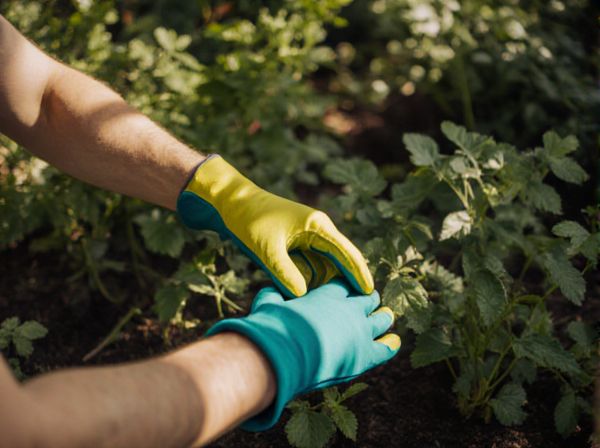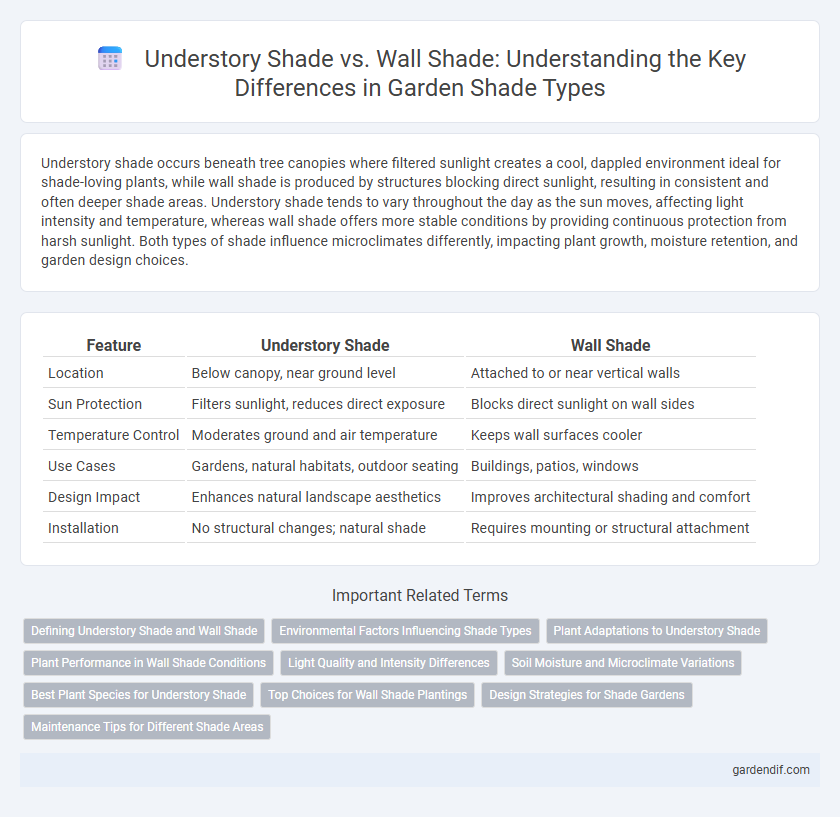
Understory Shade vs Wall Shade Illustration
Understory shade occurs beneath tree canopies where filtered sunlight creates a cool, dappled environment ideal for shade-loving plants, while wall shade is produced by structures blocking direct sunlight, resulting in consistent and often deeper shade areas. Understory shade tends to vary throughout the day as the sun moves, affecting light intensity and temperature, whereas wall shade offers more stable conditions by providing continuous protection from harsh sunlight. Both types of shade influence microclimates differently, impacting plant growth, moisture retention, and garden design choices.
Table of Comparison
| Feature | Understory Shade | Wall Shade |
|---|---|---|
| Location | Below canopy, near ground level | Attached to or near vertical walls |
| Sun Protection | Filters sunlight, reduces direct exposure | Blocks direct sunlight on wall sides |
| Temperature Control | Moderates ground and air temperature | Keeps wall surfaces cooler |
| Use Cases | Gardens, natural habitats, outdoor seating | Buildings, patios, windows |
| Design Impact | Enhances natural landscape aesthetics | Improves architectural shading and comfort |
| Installation | No structural changes; natural shade | Requires mounting or structural attachment |
Defining Understory Shade and Wall Shade
Understory shade occurs beneath the canopy of trees, where filtered sunlight creates a cooler, dim environment favorable for shade-tolerant plants and wildlife. Wall shade arises when structures such as buildings or fences block direct sunlight, casting shadows that reduce heat impact and enhance comfort in urban and residential areas. Both types of shade play critical roles in microclimate regulation and energy conservation by limiting solar radiation exposure.
Environmental Factors Influencing Shade Types
Understory shade is predominantly influenced by the density and species composition of the forest canopy, impacting light penetration, humidity, and temperature levels beneath the trees. Wall shade forms when buildings or vertical structures block direct sunlight, affecting microclimate conditions such as airflow, surface temperature, and moisture retention. Both shade types contribute to local biodiversity and thermal regulation by modifying environmental factors like solar radiation, wind patterns, and soil moisture.
Plant Adaptations to Understory Shade
Plants adapted to understory shade exhibit larger, thinner leaves with high chlorophyll content to maximize light absorption in low-light environments. These adaptations include increased leaf surface area and enhanced photosynthetic efficiency, enabling survival beneath dense canopy cover. Unlike wall shade, understory shade conditions drive plants to optimize energy capture from diffuse light filtered through foliage.
Plant Performance in Wall Shade Conditions
Plants in wall shade conditions often experience reduced photosynthesis compared to understory shade due to the altered light spectra and limited direct sunlight. Wall shade typically results in lower light intensity and increased reflected radiation, which can impact plant growth rates and leaf morphology. Adaptations such as larger, thinner leaves and enhanced chlorophyll content help plants optimize energy capture and maintain performance in these microclimates.
Light Quality and Intensity Differences
Understory shade filters sunlight through tree leaves, creating dappled, soft light with lower intensity that supports shade-tolerant plants by reducing direct sun exposure. Wall shade, produced by the shadow cast by buildings, often results in more uniform and stable shading conditions with moderate light intensity, influencing microclimate and plant growth differently than natural canopy shade. The quality of light in understory shade has higher spectral variation due to leaf filtration, while wall shade generally exhibits a more consistent light spectrum influenced by reflected ambient light.
Soil Moisture and Microclimate Variations
Understory shade typically maintains higher soil moisture levels by reducing evaporation and stabilizing microclimate temperatures beneath the canopy, promoting cooler and more humid conditions. In contrast, wall shade creates localized microclimatic variations with uneven soil moisture distribution due to limited air circulation and fluctuating sun exposure. These differences significantly influence plant stress tolerance and soil microbial activity in shaded environments.
Best Plant Species for Understory Shade
Understory shade environments benefit most from shade-tolerant plant species such as ferns, hostas, and Japanese forest grass (Hakonechloa macra), which thrive in low-light conditions beneath taller trees. These plants exhibit high adaptability to limited sunlight and contribute to maintaining soil moisture and reducing erosion. Selecting native species like the American wild ginger (Asarum canadense) enhances biodiversity and supports local ecosystems in understory shade settings.
Top Choices for Wall Shade Plantings
Top choices for wall shade plantings include hostas, ferns, and ivy, as these species thrive in low-light conditions against vertical surfaces. Wall shade creates a microclimate that reduces temperature fluctuations and retains moisture, benefiting shade-tolerant plants. Selecting drought-resistant and low-maintenance plants like hellebores ensures year-round greenery and structural interest for shaded walls.
Design Strategies for Shade Gardens
Understory shade in shade garden design utilizes the natural canopy of trees to filter sunlight, promoting diverse plant selections like ferns and hostas that thrive in dappled light. Wall shade involves structures or buildings casting shadows, creating microclimates ideal for shade-tolerant plants such as ivy and astilbe, and requires strategic placement close to vertical surfaces. Both design strategies enhance moisture retention and reduce temperature fluctuations, optimizing plant health in shaded environments.
Maintenance Tips for Different Shade Areas
Understory shade requires regular monitoring for soil moisture and leaf litter to prevent fungal growth and maintain plant health. Wall shade areas benefit from periodic cleaning to avoid mold buildup and selecting shade-tolerant plants that thrive with limited sunlight. Consistent pruning and debris removal in both shade types promote air circulation, reducing pest and disease risks.
Understory Shade vs Wall Shade Infographic

 gardendif.com
gardendif.com